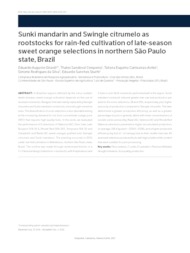Sunki mandarin and Swingle citrumelo as rootstocks for rain-fed cultivation of late-season sweet orange selections in northern São Paulo state, Brazil.
Sunki mandarin and Swingle citrumelo as rootstocks for rain-fed cultivation of late-season sweet orange selections in northern São Paulo state, Brazil.
Autoria: GIRARDI, E. A.; CERQUEIRA, T. S.; CANTUARIAS-AVILÉS, T. E.; SILVA, S. R. da; STUCHI, E. S.
Resumo: In Brazilian regions affected by the citrus sudden death disease, sweet orange cultivation depends on the use of resistant rootstocks. Rangpur lime was mainly replaced by Swingle citrumelo and Sunki mandarin rootstocks, more drought-sensitive ones. The diversification of scion selections is also desirable aiming at the increasing demand for not from concentrate orange juice (NFC) that requires high-quality fruits. In this work, we evaluated the performance of 6 selections of Valencia (IAC, Dom João, Late Burjasot IVIA 35-2, Rhode Red SRA 360, Temprana IVIA 25 and Campbell) and Natal IAC sweet oranges grafted onto Swingle citrumelo and Sunki mandarin. The planting occurred in 2001 under rain-fed cultivation in Bebedouro, northern São Paulo state, Brazil. The outline was made through randomized blocks in a 7 × 2 factorial design (selections × rootstock), with 4 replications and 2 trees in unit. Both rootstocks performed well in the region. Sunki mandarin rootstock induced greater tree size and production per plant to the scion selections, 38 and 21%, respectively, plus higher precocity of production compared to Swingle citrumelo. The later determined a greater productive efficiency, as well as a greater percentage of juice in general, albeit with lower concentrations of soluble solids and acidity. Natal IAC, Valencia IAC and Rhode Red Valencia selections presented a higher accumulated production, on average, 218.6 kg?plant?1 (2004 ? 2008), and a higher productive efficiency (kg fruit?m?3 of canopy) due to their smaller tree size. All assessed selections produced fruits with high soluble solids content that were suitable for juice processing.
Ano de publicação: 2017
Tipo de publicação: Artigo de periódico
Unidade: Embrapa Mandioca e Fruticultura
Palavras-chave: Fruta cítrica
Observações
1 - Por padrão são exibidas publicações dos últimos 20 anos. Para encontrar publicações mais antigas, configure o filtro ano de publicação, colocando o ano a partir do qual você deseja encontrar publicações. O filtro está na coluna da esquerda na busca acima.
2 - Para ler algumas publicações da Embrapa (apenas as que estão em formato ePub), é necessário ter, no celular ou computador, um desses softwares gratuitos. Sistemas Android: Google Play Livros; IOS: iBooks; Windows e Linux: software Calibre.
Acesse outras publicações
Acesse a Base de Dados da Pesquisa Agropecuária (BDPA) para consultar o acervo completo das bibliotecas da Embrapa.

